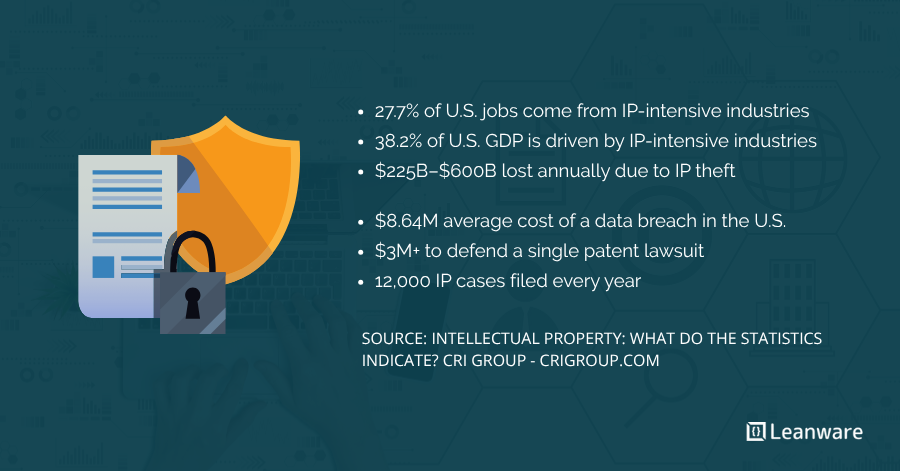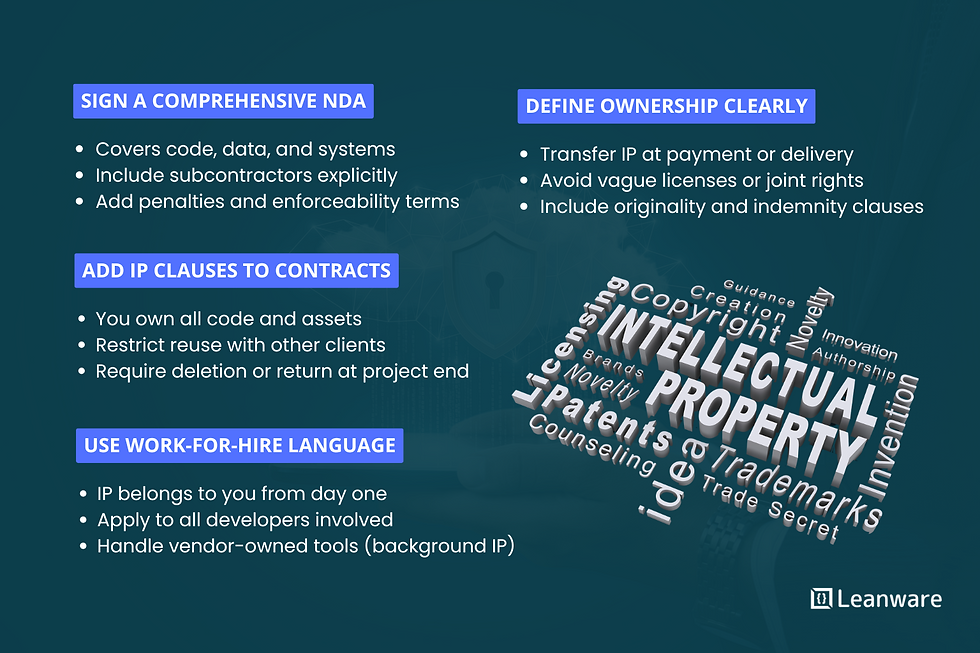How to Protect Intellectual Property When Outsourcing
- Leanware Editorial Team

- Aug 10
- 8 min read
Outsourcing software development expands execution capacity, but it also exposes your IP to real risk. When you give external teams access to your source code, architecture, internal tools, or product logic, you're handing over the core of your technical advantage.
The scale of outsourcing today makes this exposure hard to ignore. Global IT outsourcing is projected to exceed $588 billion by 2025, covering everything from infrastructure to application development. Much of that involves vendors operating in different legal systems, with uneven standards for how IP is protected and enforced.
TL;DR: Outsourcing without clear ownership and strict access control creates long-term IP exposure. Contracts aren’t enough if critical code and system knowledge are left open. This guide breaks down how to protect your core assets before the damage is done.
What Is Intellectual Property in the Context of Outsourcing?

Intellectual property (IP) in outsourcing includes all proprietary assets you either share with or build through external vendors. This isn’t just about code - it includes the logic, structure, and decisions that define how your system works. It’s your competitive edge, and when you outsource, parts of that edge move outside your internal boundary.
In software development, IP typically includes:
Source code
Database schemas
API specifications
Algorithms and heuristics
User interface designs
Business logic
It also covers less visible areas, like:
Development workflows
Testing and deployment pipelines
Data models and structuring conventions
Common Examples Include:
Source Code: All vendor-written functions, classes, and modules.
Algorithms: Logic behind recommendations, search, or fraud detection.
Design: UI mockups, branding, logos, visual systems.
Operations: Onboarding, payments, automation flows.
Trade Secrets: Customer lists, pricing, vendor configs, infra tuning.
Why IP Protection Matters in Outsourced Projects?

Outsourcing doesn’t eliminate your responsibility to protect intellectual property. Once code, logic, or internal processes leave your team, there’s risk, whether intentional or accidental.
IP theft costs the U.S. economy an estimated $225-600 billion each year, or about 1-3% of GDP. A large share of this comes from compromised vendor relationships - leaked source code, cloned features, or misused proprietary data.
For startups, the stakes are higher. Investors care about defensibility - your codebase, algorithms, and internal tools. If that IP leaks, it’s hard to justify your valuation or raise future rounds. Legal recovery is slow and expensive, and by then, the damage is already done.
Key Risks to Intellectual Property in Outsourcing
Outsourcing creates IP risks when teams operate in jurisdictions with weak legal protections. Distributed setups without proper controls can lead to leaks, misuse, or loss of ownership.
Common Threats in Software and Business Outsourcing
1. Unauthorized Code Reuse
One of the most common risks in software outsourcing is vendors reusing proprietary code across projects. This can happen intentionally or due to weak internal processes. It risks exposing your codebase to competitors and creates complications around IP ownership.
2. Unapproved Subcontracting
Some vendors subcontract work without notifying the client. If these third parties aren’t under the same legal agreements, your IP may be handled without proper safeguards. This increases the risk of leaks or disputes, especially when working across legal jurisdictions.
3. Reverse Engineering
If you outsource work involving existing systems, there’s a risk that developers could analyze and replicate business logic, algorithms, or architectural patterns. This can lead to similar solutions being built for other clients.
4. Poor Data Security Practices
Weak security controls can lead to IP exposure. Risks include storing code on unsecured servers, using shared credentials, and failing to remove sensitive data after project completion.
Jurisdiction and International IP Law Challenges
Enforcing IP rights is harder when vendors operate under different legal systems. Patent and copyright laws vary by country. What qualifies for protection in one jurisdiction may not in another.
Nearshoring to countries like Colombia, Mexico, or Canada usually means fewer legal gaps due to trade agreements and more compatible legal systems. Offshoring to countries with weaker enforcement can make IP protection slower or unreliable.
Cross-border disputes often require international arbitration. It’s costly and time-consuming, and the outcome may not justify the effort.
Consequences of IP Breach in Outsourced Agreements
An IP breach causes direct financial loss. Companies lose revenue when unauthorized parties gain access to proprietary systems or algorithms. Legal teams spend time and money on enforcement, often with limited recovery.
Teams must rework affected systems or build replacements, which delays product timelines. These delays can cause missed release targets and reduce market competitiveness.
Investors review a company’s IP history during due diligence. Breaches raise concerns and can reduce valuations or block funding.
A breach also damages credibility. Clients may withhold sensitive information, and engineers may avoid companies that don’t protect their work.
Legal Strategies to Protect Intellectual Property
Strong legal agreements are the first line of defense against IP risks in outsourcing.

1. Sign a Comprehensive Non-Disclosure Agreement (NDA)
An NDA should cover all technical and business information you share, including source code, architecture, processes, and customer data. It should apply to anything disclosed verbally, in writing, or through access to systems.
NDAs must account for subcontractors. If a vendor passes work to others, they must also be bound by the same terms.
Set a term based on your product lifecycle - typically 3-5 years in software. Include penalties for violations, including injunctive relief and damages.
Make sure the NDA is enforceable in the vendor’s home country. If it's not, it won’t protect you. Local legal review is essential.
2. Add IP Clauses to the Main Contract
In your Master Services Agreement (MSA), include IP terms that:
Confirm that all deliverables, including code and documentation, belong to your company.
Cover derivative work and improvements built during the project.
Require vendors to return or delete all IP at the end of the engagement, with proof of compliance.
Restrict the reuse of your IP or working with direct competitors, where enforceable.
3. Use Work-for-Hire Clauses in MSAs
Work-for-hire ensures that any IP created during the project belongs to you from the moment of creation.
Make sure this applies to subcontractors and individual developers, not just the vendor company. Without this, individuals could retain rights to parts of the deliverable.
Define how pre-existing vendor IP or tools (background IP) are handled. Make sure anything integrated into your deliverables is licensed or transferred.
4. Define Ownership and Transfer Terms Clearly
Set specific milestones for when IP ownership transfers - either upon delivery, approval, or payment.
Avoid ambiguous licensing. If you’re paying to build core software, own it outright. Only allow licenses for vendor-owned background IP if absolutely necessary.
Vendors must confirm that deliverables are original or properly licensed. This avoids pulling in third-party code you can’t use freely.
Add indemnity clauses that require vendors to cover you if IP infringement claims arise later.
Best Practices for Securing Intellectual Property
Legal agreements alone don’t prevent IP breaches. Use access controls, limit code exposure, enforce audit logs, and review vendor security practices during development.
1. Vet and Audit Your Outsourcing Partner
Run background checks on the company and key team members. Ask for client references, and check for prior IP-related problems.
Verify security practices, not just certifications. ISO 27001 is useful, but only if actual processes match what’s documented.
Review financial stability. A vendor under pressure is more likely to cut corners or misuse IP.
Schedule regular audits. Check for changes in staffing, access control, and compliance with your contract.
2. Limit Access to Code and Systems
Use least-privilege access. Vendors should only have access to the systems and data needed for their specific tasks.
Isolate dev environments. Don’t let external teams work in your main codebase or on production infrastructure.
Set up granular permissions in your version control system. Monitor commits, downloads, and access logs.
Review access regularly. Most IP leaks happen because access wasn’t revoked when roles or teams changed.
3. Use IP Management Tools and Processes
Code signing and digital audit trails make it easier to prove authorship and detect unauthorized changes.
Secure credential sharing prevents vendors from retaining access after a project ends. Avoid static passwords.
Monitor activity for abnormal patterns - large exports, unauthorized repo access, or unusual logins.
Track what’s shared. Use an IP asset tracker to record which vendors accessed which assets under which agreements.
4. Blockchain (Optional, High-Sensitivity IP Only)
Blockchain provides timestamped proof of IP creation and transfer. Smart contracts can automate IP ownership transfers when conditions are met.
These systems add complexity and cost, so they’re best used for high-value IP or in countries with weak legal protections.
Questions to Ask Before Signing with an Outsourcing Vendor
You can use this checklist to evaluate vendors before finalizing any deal.
1. How will my data and IP be protected?Vendors should provide clear details on their security practices - encryption, access controls, network security, and employee screening.
Check data residency rules if working across countries. Where data is stored affects which laws apply.
Ask for relevant security certifications, but don’t stop there. Review actual practices and how incidents are handled.
Request recent security assessment reports and how they addressed any findings.
2. What legal jurisdictions will apply?Governing law determines which country’s legal system interprets the contract. Choose one with strong IP protections.
Arbitration can be faster than court, but decisions are typically final with limited appeal options. Decide which route better fits your risk tolerance.
Legal and enforcement costs vary across jurisdictions. Factor this into your overall assessment. Make sure any judgments can actually be enforced in the vendor’s country.
3. Can they ensure the enforceability of IP rights?Ask if they’ve supported similar IP requirements before. Request examples. Review past IP disputes and how they were resolved.
Insurance shows they take the risk seriously, but it’s only useful after a breach. If they use IP legal counsel, confirm the advisors know your industry and region.
What Happens If You Don’t Protect Your IP?
Failing to secure your IP can lead to sustained legal, financial, and operational damage.
Litigation costs in IP cases often run into hundreds of thousands, sometimes millions, depending on the case and jurisdictions. In many cases, the legal cost exceeds the value of the stolen IP.
Loss of revenue is common when proprietary technology or methods are copied.
Investor confidence erosion affects future funding opportunities and company valuations. Venture capital firms increasingly include IP protection assessments in their due diligence processes, and companies with poor IP protection track records face reduced investment interest.
Regulatory penalties may apply if IP breaches involve customer data or violate industry-specific regulations. GDPR violations, for example, can result in fines up to 4% of annual global revenue.
Next Steps
You can start by auditing how IP is created, shared, and stored during outsourced development. Restrict access to source code, datasets, and design documents. Use role-based permissions and revoke access when it's no longer needed.
For projects involving AI or distributed teams, update agreements to cover training data, model artifacts, and external code contributions. Review regional IP laws regularly - changes can impact active contracts.
Identify weak points in how your teams handle data and access. Tighten controls before they turn into problems.
Frequently Asked Questions
1. How can you mitigate the risks to intellectual property when global sourcing?
Use comprehensive contracts with clear IP ownership clauses, thoroughly vet vendors for security practices and legal compliance, implement strict access controls that limit exposure to sensitive IP, and choose vendors in jurisdictions with strong IP law enforcement mechanisms.
2. How do you legally protect intellectual property?
Deploy non-disclosure agreements with broad confidentiality provisions, include specific IP ownership clauses in service contracts, use master service agreements with work-for-hire provisions, and register applicable patents, trademarks, and copyrights in relevant jurisdictions.
3. What are the 4 types of intellectual property protection?
Patents protect inventions and technical innovations, trademarks protect brand names and logos, copyrights protect creative works, including software code, and trade secrets protect confidential business information and proprietary processes.
4. How to protect intellectual property at work?
Educate employees about IP policies and confidentiality requirements, implement access controls that restrict IP access to authorized personnel, use comprehensive employment contracts with IP assignment clauses, and regularly monitor and audit IP usage across systems and processes.




